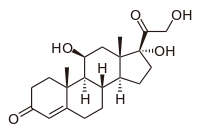
Photo from wikipedia
Background: The combination of surfactant and budesonide has been shown to decrease BPD rates and severity. Budesonide may be released systemically from lungs, and the effects on the immature adrenal… Click to show full abstract
Background: The combination of surfactant and budesonide has been shown to decrease BPD rates and severity. Budesonide may be released systemically from lungs, and the effects on the immature adrenal glands are not known. Objective: The aim of this study was to determine if adrenal suppression rates are higher in preterm infants receiving budesonide with surfactant compared to surfactant alone. Methods: A retrospective chart review of 608 infants ≤1,250 g received intubation for surfactant therapy from 2013 through 2020. In August 2016, budesonide was added to surfactant for these infants. Indicators of adrenal suppression, including mean blood pressures, plasma electrolyte levels, hydrocortisone use, and the use of vasoactive medications, were analyzed for the first 14 days after birth. Respiratory variables, biochemical signs of adrenal insufficiency, and neonatal morbidities were analyzed. Results: There was no difference in hydrocortisone administration in the first 14 days between infants receiving budesonide with surfactant (n = 314) or surfactant alone (n = 294) (23% vs. 19%, p = 0.38). Budesonide exposed infants received hydrocortisone 3 days later than surfactant only infants (median DOL 5 vs. 2, p < 0.001). Infants receiving budesonide had higher blood pressures, required less dopamine (19% vs. 39%, p < 0.001) and dobutamine (2% vs. 6%, p = 0.02). Budesonide exposed infants were discharged home after a shorter NICU stay (85 days vs. 94 days, p = 0.02) and at a younger gestational age (39 vs. 40 weeks, p = 0.001). Conclusions: The use of surfactant and budesonide does not alter the rate of hydrocortisone use, but does delay the timing of treatment initiation and decreases the use of vasoactive medications.
Journal Title: Neonatology
Year Published: 2022
Link to full text (if available)
Share on Social Media: Sign Up to like & get
recommendations!